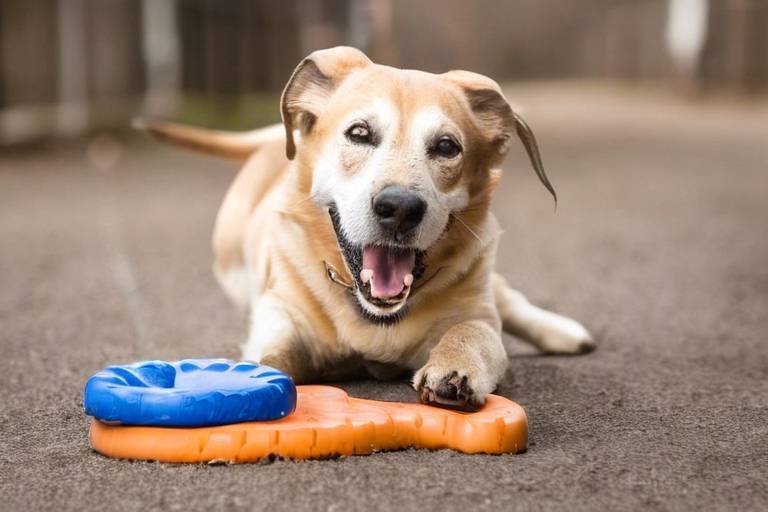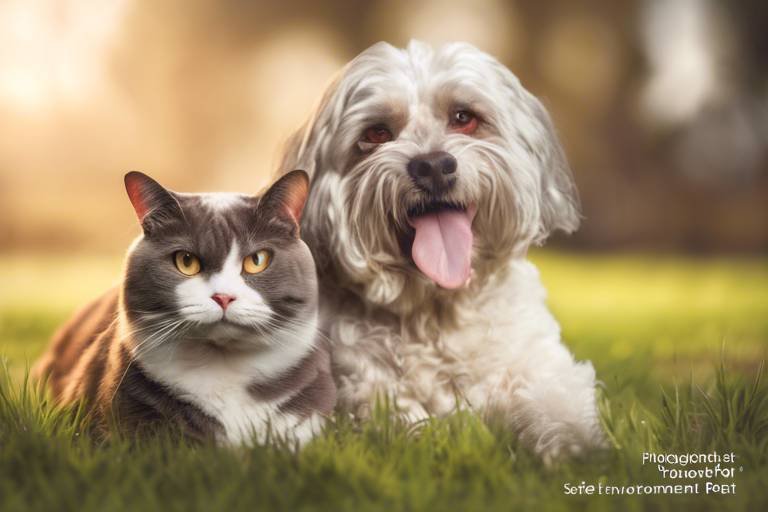Tips for Reducing Stress in Senior Pets
As our furry companions age, they often face unique challenges that can lead to increased stress and anxiety. Just like us, senior pets can experience a range of emotions and physical discomforts that may not have been present in their younger years. Therefore, understanding how to effectively manage and reduce stress in our aging pets is crucial for their overall well-being. This article provides practical strategies and insights to help pet owners navigate the complexities of caring for senior pets, ensuring a happier and healthier life for their beloved companions.
Recognizing the signs of stress in senior pets is crucial. Older animals may not express their discomfort in the same way they did when they were younger, which can make it challenging for owners to identify their needs. Common stressors include changes in their environment, health issues, and even the loss of a companion. Behavioral changes such as increased vocalization, hiding, or changes in eating habits can indicate that your pet is feeling anxious or uncomfortable. It's essential to be vigilant and attentive to these signs, as they can help you address your pet's needs more effectively.
A secure and comfortable living space can significantly alleviate stress. By arranging your home to promote relaxation and safety for your senior pets, you can create a sanctuary that caters to their needs. Start by ensuring that their favorite spots are easily accessible, especially if they have mobility issues. Consider using non-slip mats to prevent falls and create a safe pathway around furniture. Furthermore, try to keep their living area free from clutter and potential hazards, as this can help them navigate their space more comfortably.
Providing a cozy and quiet sleeping area is essential for senior pets. As they age, their need for rest increases, and a comfortable sleeping environment can greatly enhance their quality of life. Look for bedding options that offer support for their joints, such as orthopedic beds. The placement of the bed is equally important; choose a location that is away from high-traffic areas to minimize disturbances. A peaceful retreat can help your pet feel secure and relaxed, making it easier for them to recharge.
Selecting the appropriate bed material and size can help support your pet's joints and promote restful sleep, which is vital for their overall well-being. Look for beds with memory foam or gel-infused materials that contour to their body. Additionally, ensure that the bed is large enough for your pet to stretch out comfortably. A well-chosen bed can make a world of difference in how well your senior pet sleeps and, subsequently, how they feel during the day.
Reducing noise levels and distractions can create a calming atmosphere. Senior pets can be particularly sensitive to loud sounds, which can trigger anxiety. Consider using white noise machines or soft music to drown out sudden noises from outside. Additionally, try to limit the number of visitors in your home, as too many people can overwhelm your pet. By creating a serene environment, you can help your senior pet feel more at ease.
Establishing a consistent daily routine can provide a sense of security for senior pets. Animals thrive on predictability, and a regular schedule for feeding, walking, and playtime can help reduce anxiety. For example, try to feed your pet at the same time each day and take them for walks at regular intervals. This consistency not only helps your pet feel more secure but also strengthens the bond between you and your furry friend.
Gentle activities can help reduce stress and promote bonding. While senior pets may not be as active as they once were, engaging them in low-impact exercises can be beneficial. Short walks, gentle play sessions, and interactive games can stimulate their minds and bodies without overwhelming them. Remember, the goal is to keep them active but not exhausted, so always pay attention to their energy levels and adjust accordingly.
Incorporating calming techniques, such as massage or aromatherapy, can help soothe anxious pets. Gentle massages can relieve tension and promote relaxation, while certain scents, like lavender or chamomile, can have a calming effect. Consider creating a cozy space where you can spend quality time with your pet, using these techniques to help them unwind and feel secure.
Using interactive toys and puzzles can stimulate your pet’s mind while keeping them engaged. Look for toys designed specifically for senior pets that are easy to manipulate. These can provide mental stimulation and keep your pet entertained, reducing feelings of boredom and anxiety. A happy, engaged pet is less likely to exhibit stress-related behaviors, so investing in these types of toys can be a game-changer.
- What are common signs of stress in senior pets? Look for changes in behavior, such as increased hiding, vocalization, or changes in eating habits.
- How can I create a calming environment for my senior pet? Minimize noise, provide comfortable sleeping areas, and establish a consistent routine.
- Are there specific toys suitable for senior pets? Yes! Look for interactive toys that are easy to use and stimulate their minds.

Understanding Senior Pet Stress
As our furry friends age, they often face a myriad of changes that can lead to stress. Understanding senior pet stress is crucial for ensuring their well-being. Stress in older pets can manifest in various ways, and recognizing these signs early can make a world of difference. Common indicators of stress include changes in behavior, such as increased vocalization, withdrawal, or even aggression. Additionally, physical symptoms like excessive grooming, pacing, or changes in appetite may also signal that your senior pet is feeling anxious or uncomfortable.
There are numerous factors that can contribute to stress in senior pets. For instance, changes in their environment—like moving to a new home, the introduction of new pets, or even the absence of a longtime companion—can create a sense of unease. Moreover, health issues such as arthritis, vision loss, or cognitive dysfunction can exacerbate feelings of anxiety. Just like humans, pets can experience stress from both physical and emotional challenges, making it essential to be observant and proactive.
It's important to note that every pet is unique, and what stresses one may not bother another. Here are some common stressors that senior pets might encounter:
- Changes in Routine: Senior pets thrive on routine, and any disruption can lead to anxiety.
- Health Problems: Chronic pain or illness can make pets irritable and more prone to stress.
- Environmental Changes: New sounds, smells, or even furniture can be disorienting for older pets.
- Loss of Companions: The passing of another pet or family member can leave them feeling lonely and stressed.
Being attuned to your pet's emotional and physical state is vital. Regular veterinary check-ups can help identify any underlying health issues that may be contributing to their stress. Additionally, creating a stress-free environment can significantly improve their quality of life. By understanding the signs and causes of stress, you can take proactive steps to alleviate your senior pet's discomfort and ensure they lead a happier, healthier life.

Creating a Safe Environment
Creating a safe and comfortable environment for your senior pet is not just a luxury; it’s a necessity. As pets age, their needs change dramatically, and understanding how to cater to these changes can make all the difference in their quality of life. You might think of your home as a sanctuary, but is it truly a haven for your aging furry friend? Consider how you can transform your space to ensure it meets their unique requirements.
First and foremost, decluttering your living space can significantly reduce stress for senior pets. Just like humans, pets can feel overwhelmed by chaos. Imagine trying to relax in a room filled with obstacles and noise! By removing unnecessary items and creating clear pathways, you allow your pet to navigate their surroundings more easily. This simple change can make them feel more secure and less anxious.
Moreover, providing a designated safe zone can be a game-changer. This could be a quiet corner of the house, away from the hustle and bustle, where your pet can retreat when feeling stressed. Think of it as their little fortress of solitude. You can enhance this space by including their favorite blanket or a few toys, making it an inviting retreat. Having a place to escape can help your senior pet feel more in control of their environment.
One of the most critical aspects of creating a safe environment for senior pets is ensuring they have a comfortable sleeping area. Just like us, pets need their beauty sleep, especially as they age. Providing a cozy and quiet sleeping area can significantly contribute to their overall well-being. Consider the following:
When selecting a bed for your senior pet, it’s essential to choose one that supports their joints and provides adequate cushioning. Look for beds made from memory foam or orthopedic materials that can alleviate pressure points. Remember, a good night’s sleep can work wonders for their mood and health. The right bed can be the difference between a restless night and a peaceful slumber.
Noise can be one of the biggest stressors for senior pets. They may become easily startled by loud sounds or sudden movements. To create a calming atmosphere, consider using rugs or carpets to muffle sounds and reduce echoes. Additionally, you can play soft music or use white noise machines to drown out any jarring noises from outside. These small adjustments can help create a serene environment where your pet feels safe and secure.
In conclusion, by focusing on creating a safe and comfortable environment, you can significantly reduce stress for your senior pet. Remember, a little effort in modifying your living space can lead to a happier and healthier life for your beloved companion.
- What are the signs that my senior pet is stressed? Look for changes in behavior such as hiding, excessive barking, or changes in eating habits.
- How can I tell if my pet is comfortable in their environment? A comfortable pet will often relax, sleep soundly, and show curiosity about their surroundings.
- Should I consult a vet if my senior pet shows signs of stress? Yes, it’s always a good idea to consult your veterinarian to rule out any underlying health issues.
Comfortable Sleeping Areas
Creating a cozy and peaceful sleeping area for your senior pet is not just a luxury; it's a necessity. As our furry companions age, their needs change, and providing them with a comfortable space can significantly enhance their quality of life. Think of it like creating a little sanctuary where they can retreat, relax, and recharge. Imagine how you feel after a long day when you sink into a plush bed—your pet deserves that same comfort!
When designing this special spot, consider the location first. Choose a quiet corner of your home, away from the hustle and bustle of daily activities. This can be a serene nook in the living room or a cozy corner in your bedroom. The key is to ensure it's a space where your pet can feel safe and undisturbed. Additionally, ensure the area is free from drafts and direct sunlight, as both can be uncomfortable for older pets.
Now, let’s talk about the bed itself. The right bed can make all the difference! Here are some factors to consider:
- Material: Look for beds made from orthopedic foam or memory foam. These materials provide excellent support for aching joints and help alleviate pressure points, ensuring a restful sleep.
- Size: Make sure the bed is large enough for your pet to stretch out comfortably. A cramped space can lead to restlessness and discomfort.
- Washability: Choose a bed with removable and washable covers. Senior pets can sometimes have accidents, and keeping their sleeping area clean is vital for their health.
As for placement, consider elevating the bed slightly off the ground to reduce drafts and allow for better air circulation. You might also want to add a soft blanket or a familiar item that carries their scent. This can provide additional comfort and security, much like a child's favorite stuffed animal. Remember, a senior pet's bed should be a haven where they can feel completely at ease.
Incorporating these elements can transform a simple sleeping area into a true retreat for your beloved pet. Just think of it as crafting a little slice of paradise for them—one that caters to their unique needs and helps them feel secure and cherished in their golden years.
Choosing the Right Bed
When it comes to ensuring your senior pet enjoys a restful night’s sleep, is absolutely crucial. As our furry friends age, they may experience various physical changes, including joint pain and decreased mobility, which can make traditional beds less comfortable for them. Think of it like picking the perfect pillow for yourself; a bed that doesn't support your needs can lead to tossing and turning, and the same goes for our pets. So, how do we find that ideal bed for our beloved companions?
First, consider the material of the bed. Memory foam is a popular choice because it contours to your pet's body, providing support exactly where it’s needed. This is especially beneficial for pets with arthritis or other joint issues. Additionally, look for beds with orthopedic properties, as these can significantly enhance comfort and help alleviate pressure points. Remember, a well-supported pet is a happy pet!
Next, think about the size of the bed. A bed that is too small can be restrictive, while one that is too large might not provide the sense of security that your senior pet craves. Measure your pet while they are lying down to get an accurate idea of the space they need. Ideally, they should be able to stretch out comfortably without hanging off the sides. It's like finding the perfect pair of shoes; they need to fit just right to be truly comfortable!
Moreover, consider the placement of the bed within your home. Senior pets often prefer quiet, low-traffic areas where they can rest undisturbed. Placing the bed in a cozy corner or near a heat source can create a warm, inviting space for them to relax. You might even want to add some familiar blankets or toys to make it feel more like home. Just as we all have our favorite spots in the house, pets also have their preferences!
Lastly, don't forget about cleanability. Look for beds with removable, washable covers. Senior pets can sometimes have accidents or simply shed more, so having a bed that is easy to clean will save you time and stress. After all, a clean bed is a happy bed!
In summary, when choosing the right bed for your senior pet, keep in mind the following factors:
- Material: Look for orthopedic or memory foam options.
- Size: Ensure it fits your pet comfortably.
- Placement: Choose a quiet, cozy spot in your home.
- Cleanability: Opt for beds with removable, washable covers.
By taking these considerations into account, you can create a peaceful sleeping environment that will help your senior pet feel secure and comfortable. Remember, the right bed can make all the difference in your pet's quality of life, ensuring they enjoy their golden years to the fullest!
Minimizing Noise and Distractions
Creating a peaceful environment for your senior pet is essential in reducing their stress levels. Older animals, much like humans, can be sensitive to their surroundings. Imagine trying to relax in a bustling café with loud music and chatter; it’s nearly impossible! In the same way, your furry friend needs a sanctuary where they can feel safe and secure.
To minimize noise and distractions, start by identifying the common sources of stress in your home. These could be loud appliances, traffic sounds, or even the excitement of children playing. One effective strategy is to designate a quiet area in your home where your pet can retreat when they need a break. This area should be away from the hustle and bustle, perhaps in a cozy corner of a bedroom or a less frequented room.
Consider using soundproofing techniques to enhance this space. You can use thick curtains, rugs, or even soundproof panels to absorb noise. If your pet is particularly sensitive, playing soft classical music or nature sounds can create a soothing atmosphere that drowns out sudden loud noises. It's like wrapping your pet in a warm blanket of sound, providing them with comfort and tranquility.
Moreover, be mindful of your own noise levels. Keeping the volume down on televisions and radios, closing doors gently, and speaking softly can all contribute to a more serene environment. If you have other pets, ensure they are not overly rambunctious around your senior pet, as their energy can be overwhelming.
Lastly, consider the timing of certain activities. For instance, if you know that your neighborhood tends to be noisy during specific times—like trash collection or lawn maintenance—try to plan your pet’s more active hours around these disturbances. This proactive approach can help your senior pet enjoy their day without the added stress of unexpected noises.
Routine and Consistency
Establishing a consistent daily routine for your senior pet is not just a good idea; it's a vital aspect of their emotional and physical well-being. Imagine how comforting it is for us to have a predictable schedule. Now, think about your furry friend—who relies on you for everything from meals to walks. A routine can help alleviate anxiety and stress, providing them with a sense of security. When your pet knows what to expect throughout the day, it can significantly reduce feelings of uncertainty and fear.
Regular feeding times, consistent walk schedules, and designated playtimes create a rhythm that your pet can rely on. For instance, if you feed your dog at the same time every day, they will start to anticipate mealtime, which can help reduce anxiety. Similarly, if you take your cat for a short play session every evening, they will look forward to that bonding time, fostering a sense of comfort and connection. Routine is not just about structure; it’s about nurturing trust.
Moreover, keeping your pet's environment stable is equally important. Sudden changes, such as moving their bed or rearranging furniture, can be disorienting. Instead of shifting things around on a whim, consider how these changes might affect your senior pet. Routine and consistency are key to creating a sanctuary where your pet feels safe and loved.
To help you establish a routine, consider the following tips:
- Feeding: Stick to set times for meals to help regulate their digestion.
- Exercise: Schedule daily walks or gentle play sessions to keep them active.
- Rest: Designate quiet times for naps and relaxation, allowing your pet to recharge.
- Social Interaction: Allocate time for cuddling, grooming, or simply being together, which can strengthen your bond.
By implementing these strategies, you’ll not only help reduce your senior pet's stress but also enhance their overall quality of life. Remember, consistency is key! The more predictable their environment and schedule, the more relaxed and happy your furry friend will be.
Q: How can I tell if my senior pet is stressed?
A: Signs of stress in senior pets can include excessive barking, hiding, changes in appetite, or unusual behaviors. Pay attention to any changes in their routine or demeanor.
Q: Is it too late to establish a routine for my older pet?
A: It’s never too late! Senior pets can benefit greatly from a consistent routine, which can help them feel more secure and comfortable.
Q: What if my senior pet has specific health issues?
A: Always consult with your veterinarian before making changes to your pet's routine, especially if they have health concerns. Tailor the routine to accommodate their needs.
Q: Can I use calming products to help with my senior pet's anxiety?
A: Yes, there are many calming products available, such as pheromone diffusers, calming collars, and supplements. However, it’s best to discuss these options with your vet.

Engaging Activities for Relaxation
When it comes to our senior pets, keeping them engaged can be a wonderful way to reduce stress and enhance their quality of life. Just like us, our furry friends need activities that are not only enjoyable but also gentle on their aging bodies. Engaging activities can range from simple walks to interactive play sessions, and they play a vital role in providing mental stimulation and physical exercise. Think of these activities as a way to keep the spark alive in your pet's life, much like how we cherish our hobbies and interests as we age.
One of the best ways to engage your senior pet is through gentle exercise. Short, leisurely walks can do wonders for their mood and health. Imagine how refreshing it feels to step outside on a crisp morning; your pet feels the same joy! Try to find a quiet park or a safe, low-traffic area where they can explore without the stress of loud noises or bustling crowds. This not only keeps their bodies active but also allows them to enjoy the sights and smells of nature, which can be incredibly calming.
Another fantastic way to engage your senior pet is through interactive toys and puzzles. These toys are designed to stimulate your pet’s mind and can help keep boredom at bay. Picture a puzzle that rewards your pet with a treat after they solve it; it’s like a game of chess for dogs or cats! You can find a variety of options, from simple treat-dispensing balls to more complex puzzle boxes that require some effort to unlock. Just be sure to choose toys that are appropriate for your pet's size and abilities. Interactive toys not only provide mental stimulation but also encourage physical movement, which is crucial for maintaining their health.
Incorporating calming techniques can also enhance relaxation during these engaging activities. Techniques such as gentle massage can help soothe your pet while strengthening your bond. Imagine the warmth of your hand gliding over their fur, easing away tension and stress. You can also explore aromatherapy, using pet-safe essential oils to create a calming atmosphere during playtime. Lavender, for instance, is known for its relaxing properties and can help create a serene environment for your furry friend. Just remember to consult with your vet before introducing any new products.
To wrap it all up, engaging activities for relaxation are essential for our senior pets. They not only help to reduce stress but also promote physical health and emotional well-being. By incorporating gentle exercise, interactive toys, and calming techniques into their daily routine, you can create a fulfilling environment that keeps your beloved companion happy and content. After all, a happy pet means a happy owner!
- What are some signs that my senior pet is stressed? Look for changes in behavior such as excessive barking, hiding, changes in eating habits, or destructive behavior.
- How often should I engage my senior pet in activities? Aim for short sessions of 10-15 minutes a few times a day, adjusting based on your pet’s energy levels.
- Can I use regular toys for my senior pet? Yes, but ensure they are not too challenging and are appropriate for their physical capabilities to avoid frustration.
Calming Techniques
When it comes to our beloved senior pets, ensuring they feel calm and secure is of utmost importance. Just like humans, older animals can experience anxiety, and finding effective can make a world of difference. One popular method is massage therapy. This gentle touch not only helps relax tense muscles but also promotes a deeper bond between you and your furry friend. Think of it as a mini-spa day for your pet! Take your time, use slow strokes, and watch as your pet melts into relaxation.
Another effective technique is aromatherapy. Certain scents, like lavender and chamomile, are known for their calming properties. You can use essential oils in a diffuser or even apply diluted oils to your pet’s bedding. Just ensure that the oils are pet-safe, as some can be harmful to animals. Imagine transforming your home into a serene oasis where your pet can unwind and feel at peace!
In addition to these methods, creating a soothing environment can help reduce stress levels. Consider using soft music or white noise machines to drown out sudden sounds that might startle your pet. A consistent and quiet atmosphere can be incredibly beneficial. You might even want to dedicate a special corner of your home as a “relaxation zone” where your pet can retreat whenever they need a break. This space can be adorned with their favorite toys, blankets, and perhaps even a calming pheromone diffuser to help ease their worries.
Here’s a quick overview of some calming techniques:
- Massage Therapy: Gentle strokes to relax muscles and enhance bonding.
- Aromatherapy: Use pet-safe essential oils like lavender for a calming effect.
- Soothing Sounds: Soft music or white noise can mask stressful noises.
- Relaxation Zone: Create a dedicated space with comfort items for your pet.
Lastly, don’t underestimate the power of positive reinforcement. Rewarding your pet with treats or affection when they display calm behavior can reinforce their sense of security. It’s like giving them a little gold star for being brave! Remember, patience is key. It may take some time for your senior pet to fully embrace these calming techniques, but with your love and support, they can find their way to a more peaceful state of mind.
Q: How can I tell if my senior pet is stressed?
A: Look for signs such as excessive barking, hiding, changes in appetite, or destructive behavior. If your pet seems unusually anxious, it's a good idea to explore calming techniques.
Q: Are there specific essential oils safe for pets?
A: Yes, oils like lavender and chamomile are generally safe for pets, but always consult your vet before introducing any new products.
Q: How often should I use these calming techniques?
A: You can incorporate these techniques as needed, especially during stressful situations like thunderstorms or when introducing new environments.
Interactive Toys and Puzzles
When it comes to keeping our senior pets happy and engaged, can be a game changer. Imagine your furry friend, once a bundle of energy, now moving a bit slower but still eager to explore the world around them. These toys not only provide entertainment but also stimulate their minds, helping to keep cognitive decline at bay. Just like us, pets need mental exercise to stay sharp, and interactive toys are perfect for this purpose.
There are various types of interactive toys available that cater specifically to the needs of senior pets. For instance, consider toys that dispense treats as your pet interacts with them. These toys encourage movement and problem-solving, which can be incredibly rewarding for your pet. It’s like a treasure hunt for them, and they get a tasty reward at the end! Some popular options include:
- Puzzle Feeders: These require pets to figure out how to get their food or treats, promoting both physical and mental activity.
- Snuffle Mats: These mats mimic grass and allow pets to forage for hidden treats, tapping into their natural instincts.
- Interactive Ball Toys: These can be filled with treats and encourage your pet to roll them around to get their reward.
Choosing the right toy is essential. Look for products that are designed with senior pets in mind, ensuring they are easy to manipulate and safe to use. Avoid toys with small parts that could pose a choking hazard. Additionally, consider your pet's physical abilities; some may prefer softer toys that are gentle on their joints, while others might enjoy the challenge of a more intricate puzzle.
Moreover, incorporating these toys into your pet's daily routine can enhance their overall well-being. Set aside a few minutes each day for interactive playtime. Not only does this provide mental stimulation, but it also strengthens your bond with your pet. Think of it as a mini workout for their brain, where every puzzle solved brings a sense of accomplishment and joy.
Lastly, remember that patience is key. Just as we might struggle with a tricky puzzle, so can our pets. Celebrate their efforts, and don’t get frustrated if they take a while to figure things out. The goal is to keep them engaged and entertained, fostering a sense of happiness and reducing stress in their golden years.
Q: How do I know if my senior pet is bored?
A: Signs of boredom can include destructive behavior, excessive sleeping, or a lack of interest in activities they once enjoyed. If your pet seems restless or is seeking attention more than usual, it might be time to introduce some new toys or activities.
Q: Are interactive toys safe for all senior pets?
A: While many interactive toys are designed with safety in mind, it's essential to choose toys that suit your pet's specific health needs and abilities. Always supervise your pet during playtime, especially with new toys, to ensure they are using them safely.
Q: How often should I rotate my pet's toys?
A: Rotating toys every few weeks can keep your pet interested and engaged. It’s like giving them new toys without the expense of buying new ones!
Q: Can interactive toys help with anxiety in senior pets?
A: Yes, interactive toys can provide mental stimulation and distraction, which may help alleviate anxiety. Engaging your pet in play can also strengthen your bond and create a sense of security.
Frequently Asked Questions
- What are the common signs of stress in senior pets?
Senior pets may exhibit various signs of stress, including changes in appetite, excessive barking or meowing, hiding, aggression, or even changes in their sleeping patterns. If you notice any of these behaviors, it's essential to assess their environment and routine for potential stressors.
- How can I create a safe environment for my aging pet?
To create a safe environment, ensure that your home is free from hazards, such as sharp objects or slippery surfaces. Designate a quiet area with comfortable bedding where your pet can retreat when feeling anxious. Keeping their space clutter-free and familiar can also help them feel more secure.
- What type of bed is best for senior pets?
When choosing a bed for your senior pet, look for options that provide ample support for their joints, such as orthopedic beds. The bed should be the right size and made of soft, comfortable materials to encourage restful sleep and reduce anxiety.
- How can I minimize noise and distractions for my pet?
To minimize noise and distractions, consider using soundproofing materials, such as heavy curtains or rugs, to dampen sounds. Additionally, creating a designated quiet zone away from household activity can help your pet feel more at ease.
- Why is routine important for senior pets?
Establishing a consistent routine is crucial for senior pets as it provides them with a sense of security. Regular feeding, walking, and playtime help them know what to expect each day, reducing anxiety and promoting overall well-being.
- What are some calming techniques I can use for my stressed pet?
Calming techniques such as gentle massage, aromatherapy, or soft music can significantly soothe anxious pets. Experimenting with different methods can help you find what works best for your furry friend.
- Are interactive toys beneficial for senior pets?
Absolutely! Interactive toys and puzzles can provide mental stimulation while keeping your senior pet engaged. These activities can help alleviate boredom and reduce stress, making playtime enjoyable and beneficial for their mental health.



















